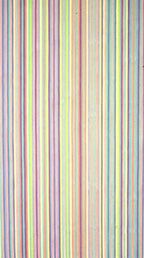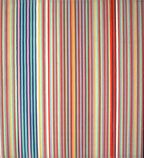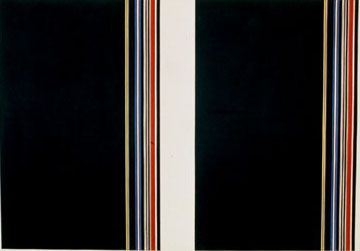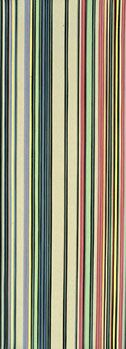 |

| |




|
 Gene Davis/ Paintings, watercolors, prints & drawings:
Works from the Estate of the Artist
Gene Davis/ Paintings, watercolors, prints & drawings:
Works from the Estate of the Artist
September 18 - October 30, 2004
Reception: Friday, October 1, 6 - 8 pm.

In an interview for ArtForum in 1971, Gene Davis explained to art historian Barbara Rose that "The only requirement I make of art, and this may sound a little simplistic, is that it look good and continue looking good with the passage of time".
( 1) By the artist's own measure, his works easily stand the test of time. Now, in the 21st century his paintings, drawings, watercolors and prints, are as fresh and engaging as they were when he created them, two generations ago.
Gene Davis gained critical acclaim in the late 1950's for his abstract paintings. Linked by critic Clement Greenberg to the "Washington Color School", which included
Morris Louis and Ken Noland, Gene Davis became famous for the overall stripe format.
When asked "Why Stripes?", Gene Davis replied "It seemed to me to offer a way out of the loose biomorphic form characteristic of most of the work executed around
1957-58." ( 2 ) Initially working in evenly spaced stripes, the artist broadened his use of the stripe over his career to include every possible variation, almost always in
vertical orientation. This rigid and formal structure was in deliberate contrast to the artist's avowed intuitive approach to color. The stripe was his subject, color its
expression.
Gene Davis' use of color was astonishingly varied and personal. When asked if he had theories about color, he said "I'm governed by whim, intuition and mood within
the framework of the stripe format. The passage of time involved in painting the picture is going to bring with it, of necessity, a lot of mood changes‚§ďa lot of
unpredictable things." ( 3 ) In the interview with Barbara Rose, he compared beginning a painting to a jazz musician's bouncing off a standard tune. " I'm the most
intuitive of painters. ...I often will use the color I have the most of...and trust my instincts. ...whatever I happened to have around is put on because I have to bounce
off of things, I have to get something started. I've got to get some red or some green up there on the canvas then I start off and I paint my way out of the painting" .
( 4 ) To appreciate a finished painting, the artist recommended to the viewer the same approach of selecting a specific color. "Instead of glancing at the work, select a
specific color such as yellow or lime green, and take the time to see how it operates across the painting. Approached this way, something happens. I can't explain it.
But one must enter the painting through the door of a single color. And then you can understand what my painting is all about. ....if the viewer selects individual colors and looks at them across the surface of the work, he's almost reliving the painting process, because I often do put all of one color down at one session. And then Iíll come back and use another color. The viewer begins to see how this single color reacts in all its different relationships with other colors. Also, the spectator is, in a sense, entering into kind of a time experience in the same way that I did when I painted it." ( 5 ) The current exhibition of works from the Estate of Gene Davis is the fourth solo exhibition for the artist at the Marsha Mateyka Gallery. It includes early watercolors from 1956, micro paintings and prints from the late 1960's, and paintings from the 1980's.
Before Gene Davis moved away from the Abstract Expressionist motif, he painted a series of watercolors which represent his innate feeling for color as well as his
interest in the works of Paul Klee. The complex and brilliant "Series 1", a suite of silkscreen prints printed on fabric, was created in 1969 when Gene Davis' major style
was well established and in full bloom.
The artist's keen interest in experimenting with wild variations in scale is represented in a cluster of "micro paintings", each no bigger than 1 inch. ( On the other end of
the scale, the artist created such site specific paintings as "Franklin's Footpath", a mile of stripes painted in 1972 on the pavement in front of the Philadelphia Museum
of Art. )
Finally, in the current exhibition, there are four mid-size paintings, two of which were created in the last four months of his life. These last two paintings exhibit a
restrained use of color played off of large blocks of black or raw canvas.
Gene Davis's paintings are in major museums throughout the country, including Chicago Art Institute, Whitney Museum of American Art, Guggenheim Museum, Walker Art Center, The Phillips Collection, Corcoran Gallery of Art, Hirshhorn Museum, Smithsonian American Art Museum, and National Gallery of Art, Washington, DC..
1. Gene Davis, Interviews by Walter Hopps, Barbara Rose, Donald Wall, edited by Donald Wall, 1975, Praeger Publishers, New York., p. 137
2. ibid. p.27
3. ibid p. 57
4. ibid p. 138
5. ibid p. 31 - 32
|
|
| 

|

